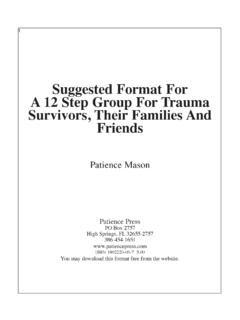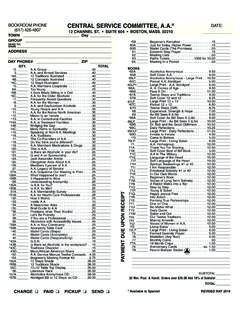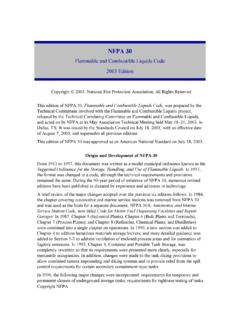Transcription of MAA EZ - ARG
1 MAA*EZ. *. NA, too Making Alcoholics Anonymous Tlaloc petroglyph in Northern Jornada Mogollon Region, New Mexico Easier developed by Lee Ann Kaskutas and Edward Oberste Alcohol Research Group Berkeley, CA 94709. Acknowledgments: This manual was developed with funding from the National Institute on Alcohol Abuse and Alcoholism, Grant P50 AA05595-21 to the Alcohol Research Group. Special thanks to Sue Diehl (graphics) and Drs. Thomasina Borkman, Constance Weisner and David Pating (content). 2002 Public Health Institute TABLE OF CONTENTS. maaez The Session Content ..7. Session Format ..8. Conducting Clinic Requirements ..11. Scientific Studies of AA Sample maaez Session INTRODUCTION. SPIRITUALITY. PRINCIPLES, NOT PERSONALITIES. SPONSORSHIP. LIVING SOBER. Introduction The desired outcome of maaez is to facilitate participation in Alcoholics Anonymous and/or in other 12-step programs such as Narcotics Anonymous and Cocaine Anonymous.
2 It regards such active involvement as important for sustained abstinence. The intervention prepares clients for a transition into the culture of Alcoholics Anonymous. It does this by addressing some of the myths about AA and by creating a safe environment for clients to honestly share their experiences with 12-step programs (both positive and negative). maaez is delivered in a group rather than an individual setting because the group dynamic helps the individual prepare for the group process of Alcoholics Anonymous. maaez requires the counselor to function alternately as educator (instilling knowledge about AA) and as facilitator (focusing interactive group discussion). The counselor should be supportive and encouraging as opposed to confrontational. The counselor needs to create a mutually supportive environment in which participants do not criticize one another, but where they are allowed to voice their concerns about AA.
3 Members of the group need to know that the group is safe, that whatever is said within the group will not be discussed anywhere else, and that the group exists for their benefit--conditions which also are in place at AA/NA/CA meetings. maaez does, however, allow for feedback, unlike where directly responding to what someone says is considered cross talk.. -3- Objectives The primary objective of maaez is to equip clients to deal with some of the experiences they are likely to encounter in an aa meeting , so that they will not immediately reject AA as a potential source of help. maaez is not intended as a summary of AA concepts nor as a intervention that teaches the program of recovery as outlined in the AA Big Book : those tasks are left to the fellowship of AA. Rather, maaez is meant to soften newcomers' resistance to AA so that they do not quit going to AA before they have had a chance to see how the fellowship and the AA program can help them.
4 The approach underlying maaez is grounded in the principles of AA, but the intervention has no official relationship with or sanction from Alcoholics Anonymous. This is because of the AA traditions of not endorsing outside enterprises (tradition 6) and of remaining non-professional (tradition 8). AA does not sponsor or conduct research into alcoholism or its treatment, nor does AA endorse any treatment program or method. -4- maaez Structure maaez consists of six weekly 90-minute sessions, each with a 10 minute break. To implement the group intervention, two maaez sessions must be conducted weekly at the facility: Each week, an introductory session must be offered for new clients Each week, one of the four core sessions must be offered for continuing clients The introductory session is the only session that needs to be held every single week. It serves two purposes, to introduce new members to the group and as a guest speaker session for graduates.
5 The introductory session is always session #1 for incoming clients. It also always serves as session #6 for program graduates, who attend the introductory session as a senior peer for the newcomers. This serves three functions. First, the positive AA. experiences of the maaez graduates serve as a credible counterpoint to the negative AA experiences many clients will bring to their first session. Secondly, it offers the opportunity for graduating clients to experience the positive therapeutic benefit of being in the service-oriented role of ?helper. Third, it means that the counselor is not alone in contending with clients' negative AA experiences. The other four sessions do not need to be experienced in any particular order. One different core session should be offered each week, so that all four core sessions are covered within a 4 week period. To review: Clients attend the introductory session as their first session.
6 For the next 4 weeks, they attend the four core sessions being cycled through the facility, in whatever sequence they are currently being presented. The 6th week, they return to the introductory session as a program graduate whose experiences will be drawn upon as an essential component of the introductory session for new participants. (For the first-ever Introductory session at a clinic, there will be no program graduates, so the counselor must instead explain his or her own experiences with AA as a one-time substitute for this important part of the maaez intervention.). A 6-week treatment cycle has been chosen for maaez for three reasons. First, the intervention needed to be consistent with the length of stay at most outpatient programs. Related, we wanted maaez to be short, so as to minimize the time commitment for the newcomer. Last, we wanted to cover the key objections to and benefits of 12-step program involvement, and this required an initial introductory session, four content sessions, and a graduation session as ?
7 Helper.. -5- The Facilitator The sessions should be led by an active AA, NA or CA member who is also adept at facilitating groups. The counselor who facilitates the maaez groups should be capable of answering questions about sponsorship, the AA steps and traditions, and the types of meetings available in the geographic area. Counselors in maaez . should rely on the fellowship of Alcoholics Anonymous to serve as an instrument of change in the clients'. pursuit of sobriety. While the counselor should make every effort to cultivate a warm and safe group environment, it is essential to continually focus the group on the fellowship of AA as an agent of change. -6- Session Content There are five separate curriculums to maaez . These particular curriculums were chosen to provide tangible help to the newcomer--such as how to pick which meeting to go to, how to ask someone to be your sponsor, and how to understand some of the language and culture of the AA fellowship that they will inevitably encounter at AA meetings.
8 These curriculums were also selected to candidly address known reasons for resistance to AA such as its spirituality component and the diversity of personalities and opinions. The INTRODUCTION session focuses on the benefits of attending AA and how to choose meetings The SPIRITUALITY session provides clients with a wide range of definitions of spirituality that do not all require a religious orientation or God belief system, but that are consistent with AA's emphasis on spirituality. AA is a spiritual program but not a religion. The PRINCIPLES, NOT PERSONALITIES session deals head-on with myths about AA, different types of AA meetings, and AA etiquette and ritual. The SPONSORSHIP session explains the function of an AA sponsor, offers guidelines for picking an appropriate person, and includes role-playing to practice asking for a temporary sponsor, overcoming a rejection, etc.
9 In the LIVING SOBER session, tools for staying sober are tackled: triggers to relapse, service, and avoiding slippery people, places and things. -7- Session Format Each 90-minute maaez session involves a 15 minute check-in, about 55 minutes dedicated to the session topic (with a 10- minute break mid-way through the discussion), a 5-minute summary, and 5 minutes to explain next week's homework assignment. Check-in Each session begins with a 15-minute check-in. In the introductory session, this time is used to introduce all of the clients to one other and to the counselor. In the core sessions, the check-in is used to report on homework assignments, with names picked at random to determine who will have a chance to discuss their homework assignment that particular week. However, any ?burning desire to share is also honored. This mimics the reality at AA meetings, in which everyone does not always have the opportunity to share.
10 Topic The core session topic is then presented by the counselor. For each session, a counselor outline is provided, which includes the essential points that need to be communicated to the clients. Opportunities to engage the group are suggested throughout the outline and are labeled with the following symbol: A section on Conducting the Sessions (see next chapter) provides instructions for employing the group dynamic when this symbol is used. It is generally important to touch upon every point and sub-point in the outline during the course of the 90-minute session. The only exception to this is in the PRINCIPLES, NOT. PERSONALITIES session where each common objection to AA need not be covered. Summary Each core session outline ends with a Summary of the session's three ?take-home messages. The counselor should ask what ideas stood out for members of the group at the end of the session.


